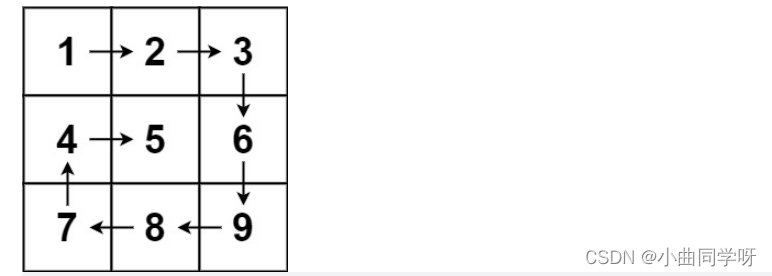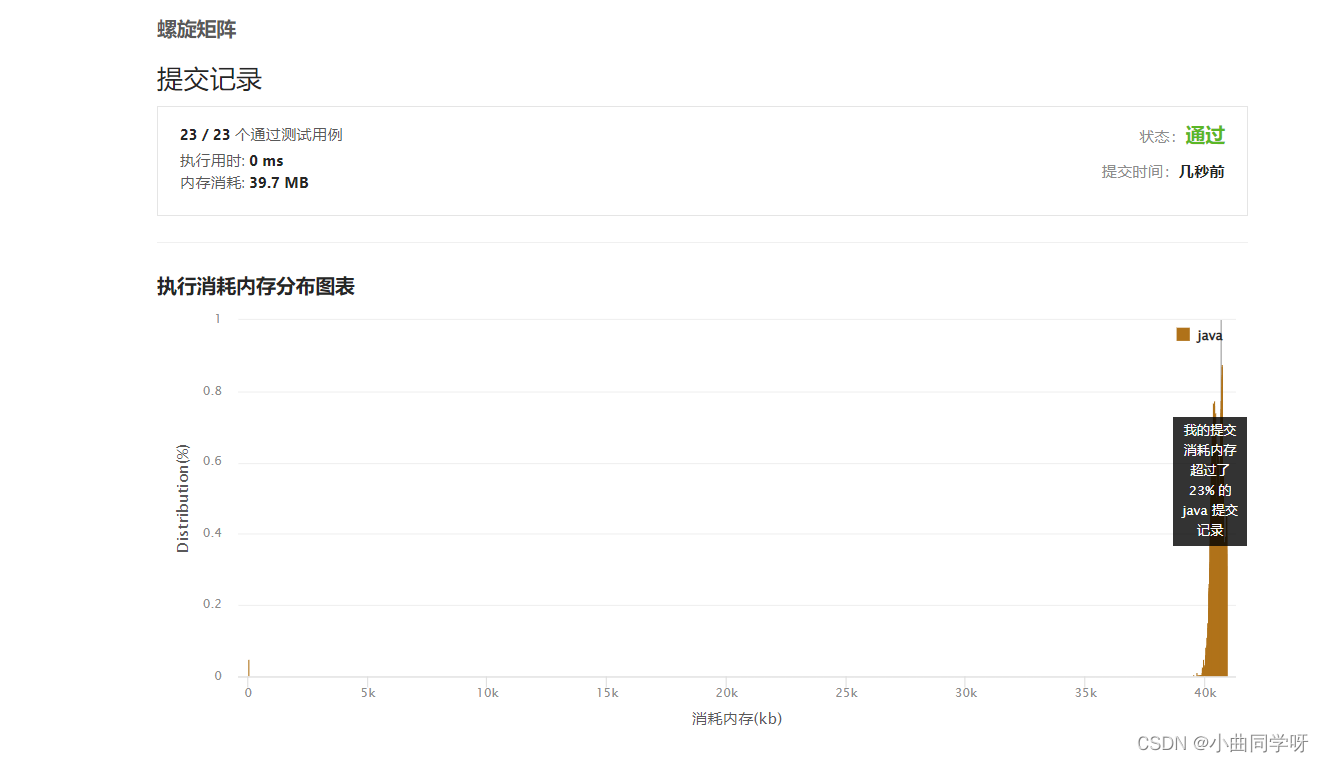-
【LeetCode】54、螺旋矩阵
54、螺旋矩阵
题目:
给你一个
m 行 n 列的矩阵matrix,请按照 顺时针螺旋顺序 ,返回矩阵中的所有元素。示例1:

输入:matrix = [[1,2,3],[4,5,6],[7,8,9]] 输出:[1,2,3,6,9,8,7,4,5]- 1
- 2
示例2:

提示:m == matrix.length
n == matrix[i].length
1 <= m, n <= 10
-100 <= matrix[i][j] <= 100解题思路:
可以模拟螺旋矩阵的路径。初始位置是矩阵的左上角,初始方向是向右,当路径超出界限或者进入之前访问过的位置时,顺时针旋转,进入下一个方向。
判断路径是否进入之前访问过的位置需要使用一个与输入矩阵大小相同的辅助矩阵
visited,其中的每个元素表示该位置是否被访问过。当一个元素被访问时,将visited中的对应位置的元素设为已访问。如何判断路径是否结束?由于矩阵中的每个元素都被访问一次,因此路径的长度即为矩阵中的元素数量,当路径的长度达到矩阵中的元素数量时即为完整路径,将该路径返回。
复杂度分析
时间复杂度:
O(mn),其中 m 和 n 分别是输入矩阵的行数和列数。矩阵中的每个元素都要被访问一次。空间复杂度:
O(mn)。需要创建一个大小为m×n的矩阵visited记录每个位置是否被访问过。参考代码:
class Solution { public List<Integer> spiralOrder(int[][] matrix) { List<Integer> order = new ArrayList<Integer>(); if (matrix == null || matrix.length == 0 || matrix[0].length == 0) { return order; } int rows = matrix.length, columns = matrix[0].length; boolean[][] visited = new boolean[rows][columns]; int total = rows * columns; int row = 0, column = 0; int[][] directions = {{0, 1}, {1, 0}, {0, -1}, {-1, 0}}; int directionIndex = 0; for (int i = 0; i < total; i++) { order.add(matrix[row][column]); visited[row][column] = true; int nextRow = row + directions[directionIndex][0], nextColumn = column + directions[directionIndex][1]; if (nextRow < 0 || nextRow >= rows || nextColumn < 0 || nextColumn >= columns || visited[nextRow][nextColumn]) { directionIndex = (directionIndex + 1) % 4; } row += directions[directionIndex][0]; column += directions[directionIndex][1]; } return order; } }- 1
- 2
- 3
- 4
- 5
- 6
- 7
- 8
- 9
- 10
- 11
- 12
- 13
- 14
- 15
- 16
- 17
- 18
- 19
- 20
- 21
- 22
- 23
- 24
- 25

-
相关阅读:
SQL Server对象类型(5)——4.5. 同义词(Synonym)
Zookeeper快速入门(Zookeeper概述、安装、集群安装、选举机制、命令行操作、节点类型、监听器原理)
ValueAnimator的一些骚玩法
四、MyBatis-Plus 查询
前端技术选型与探索
Go语言类型与接口的关系
企业电子招标采购系统源码Spring Boot + Mybatis + Redis + Layui + 前后端分离 构建企业电子招采平台之立项流程图
Python问题:树的镜面映射
商品销售管理系统java+mysql
(AS笔记)Android选择图片+HttpURLConnection表单POST上传图片到后端
- 原文地址:https://blog.csdn.net/weixin_44427181/article/details/126619473
